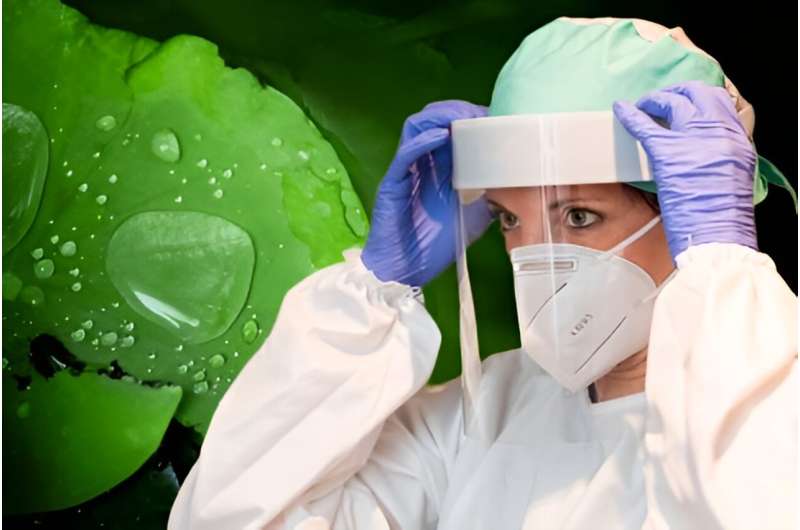This article has been reviewed according to Science X's editorial process and policies. Editors have highlighted the following attributes while ensuring the content's credibility:
fact-checked
trusted source
proofread
Student researchers turn to lotus plant to design fog-free personal protective equipment

Students at the University at Buffalo School of Dental Medicine applied the science behind why water beads up on lotus leaves to solve a pesky problem that arose during the coronavirus pandemic.
Under the direction of Praveen Arany, Ph.D., associate professor of oral biology, the students created free face shields and comfort bands as a type of personal protective equipment (PPE) with 3D printers that were eventually used by some 3,000 dental professionals in university centers across the country. First, however, the students had to figure out how to prevent the shields from fogging up, which makes it hard for wearers to see.
Commercially available anti-fogging solutions found in eyeglasses and car exteriors were not suitable due to their potential to irritate the skin or cause sickness if inhaled or ingested, Arany explained.
Lotus leaves provided a eureka moment for the researchers.
"The hydrophobic nanostructure keeps water from being absorbed in the leaves," Arany explained. "They float and secrete a natural wax."
After looking at several formulations of wax that would keep the PPEs clear and non-toxic, the research team discovered that a combination of carnauba and beeswax created optimal results.
"With a couple of adjustments, the condensation just rolled off," Arany said.
The researchers' discovery is explained in a paper published Aug. 28 in Peer J Materials Science and authored by students Succhay Gadhar, Shaina Chechang and Philip Sales, with Arany.
The idea for the project came about because dentists needed clear shields that also could accommodate dental loupes, the magnifying glasses they wear while examining patients' mouths.
The dental school's 3D printers, which had previously been used to create and investigate medication-filled 3D-printed dentures, smart fillings and bone regenerative scaffolds, were sitting idle once the pandemic hit.
"The strategy was to create something like N-95 masks that were transparent," Arany said. "The pandemic, with its need for protective masks and suits, exacerbated the fear that some people have of dentists. Because of the opaque nature of the masks, nonverbal cues were missing."
Students started working with Arany in spring 2020, and they continued to perfect them over the next year, including solving the fogging issue. They also discovered that isopropyl alcohol provided the best disinfectant for the reusable shields that wouldn't disrupt the anti-fogging agents and figured out how to shape the masks at a slight angle so that the edge wouldn't hurt the wearer's face.
Remarkably, Gadhar, one of the primary researchers, was a student at Williamsville North High School (Amherst, New York) at the time. He read about the PPE project in the local news and wanted to help rectify the condensation problem, Arany said. Through a largely online collaboration, he was invited to join the research team and came up with the exact formulations that were eventually tested in the lab. He's now a biomedical engineering student at the University of Texas at Austin.
Chechang, who was a third-year dental student and is now an oral surgery intern at the University of Chicago, performed the sterilization studies based on her ongoing clinical use of the PPEs. Sales, then a master's student in biological sciences and now a second-year dental student at UB, led the 3D printing design and manufacturing that took place in Foster Hall on the South Campus.
Jaewon Kim, a former periodontics resident who now serves as an assistant clinical professor at the University of Oklahoma's College of Dentistry, and Jacob Graca, then a third-year dental student who is now a practicing general dentist in Redondo Beach, Calif., also made key contributions to the study.
A total of 20 students contributed to the research and the 3D printing, along with designing and operating a PPE website and manufacturing and delivering the PPE devices.
They received emergency-use authorization approval from the Food and Drug Administration to make and disseminate the face shields. Along with the dental professionals who benefited from the free face shields, health professionals at Buffalo General Medical Center and Oishei Children's Hospital also used them during the pandemic.
"This was a great learning experience for my students and for me," Arany said. "The masks were really needed, and we were thrilled to be assisting our clinical colleagues during this critical time."
Although clinical professionals are currently not required to wear PPEs, this could change if spread of the new coronavirus variant, BA.2.86, results in health care settings adopting stricter cautionary measures.
"The design principles are there," Arany said. "It's something we could manufacture again if and when needed."
More information: Succhay Gadhar et al, Durability and physical characterization of anti-fogging solution for 3D-printed clear masks and face shields, PeerJ Materials Science (2023). DOI: 10.7717/peerj-matsci.30




















